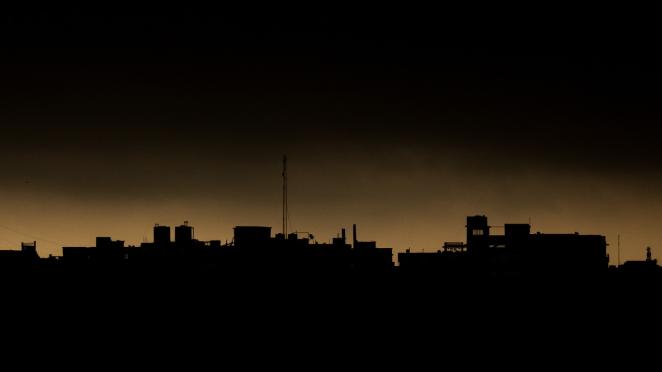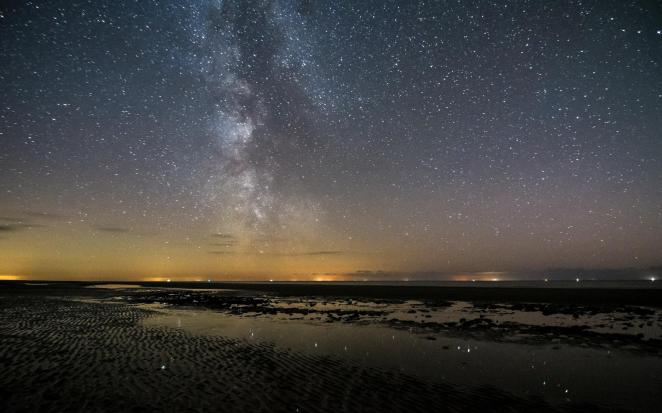Background
In response to the growing concerns surrounding the negative impacts of light pollution, the Monitoring Committee of the Interreg North Sea Programme 2021-2027 approved the project application of 'KID – Keep it Dark' on 29 June 2022. This small-scale project seeks to develop a monitoring network to reliably measure light pollution, so to address the current lack of a sound methodology to track the pollution trends accurately. The project is focused specifically on analysing Artificial Light at Night (ALAN) in the Wadden Sea area. This UNESCO World Heritage Site is one of the darkest regions in Europe, but like many such places, it is increasingly affected by light.

Light as a Pollutant
In short, light pollution refers to excessive or improperly directed artificial light, which is produced by humans, and which disrupts the natural darkness of the night. Mankind has been using various forms of artificial light for centuries on end. Think of the discovery of fire by early humans, and the creation of candles and oil lamps by ancient civilisations. A significant increase in the intensity and prevalence of ALAN began during the late 19th and early 20th centuries with the advent of electric lighting. The world witnessed rapid urbanisation and industrialisation, which brought more and more light along with it. Advancements in lighting technology, particularly the widespread adoption of fluorescent and later, LED lighting, further intensified the issue of light pollution. These sources of light might be more energy-efficient but often also produce more intense light, contributing increasingly to skyglow, causing the night sky's natural darkness to be compromised.
As globalisation accelerated, the trouble of light pollution spread further and further across our planet. The expansion of outdoor (and indoor) lighting - like streetlights, agricultural greenhouses, factories, offices, sporting venues, illuminated advertisements, and aesthetic lighting - has numerous advantages and has drastically changed the way we live, work, and communicate. However, it can simply not only be seen as a matter of progress.
The Dead of Night
The rise of ALAN moved quickly; gradually, but swiftly. This made it somewhat difficult for people to realise just how much brighter the world was becoming. Only in recent decades has there been a growing awareness of the numerous impacts of light pollution. And there are many.
For centuries, when one would look up to the night sky, one would have been overwhelmed by countless little dots of light, sparkling in the darkness of the night. Our ancestors looked up to the night sky with admiration, fascination, and a seemingly intrinsic desire to know more. Today, we are not much different in that regard, but we have entered an era in which this deep-rooted inherent human curiosity is getting progressively harder to satisfy. Ground-based astronomical research and amateur stargazing - an attempt to push the boundaries of our knowledge and a way to momentarily escape the hustle of daily existence - are being hit hard by our accustomed thirst for light. Take for example the Milky Way - our home; the galaxy in which we reside. From Earth, we see the Milky Way as a band of faint light stretching across the night sky. Unfortunately, this is no longer something for everyone to enjoy. About a third of the world's population no longer sees this phenomenon appear at night at all, and about 60% of Europeans have lost sight of our own galaxy entirely.
Next to this, excessive exposure to artificial light at night also affects our wellbeing. Our biological clock, a resilient system in sync with the natural rhythm of day and night, that has evolved over millions of years, governs sleep-wake cycles, hormone regulation, and various physiological functions. With the rise of light pollution, our circadian rhythms are disturbed as ALAN interferes with the production of melatonin. This may lead to sleep loss or even insomnia, diminished sleep quality, potential health issues, and a negative impact on daily activities.
But, we are not the only ones impacted. The nature surrounding us is also deeply connected with the daily cycle of day and night. The disturbance thereof affects every organism, animal or plant, differently. For instance, there are plants that only open up their flowers when it is dark so they can be pollinated by insects, which now happens less frequently. Certain insect species are misled by artificial light, so they deposit their eggs on surfaces like asphalt instead of water, where the eggs cannot hatch. Toads postpone their migration. Bats avoid areas with light and thus their habitats are becoming severely limited. Consider migratory birds as well. They navigate partly based on the light of stars and the moon, and light pollution causes disorientation. Birds become trapped in ALAN, losing their ability to use their regular navigation methods completely. This can have severe consequences, such as losing their way entirely, being unable to find food and a resting place, leading to exhaustion and possibly death. It can affect individuals, but also entire populations, disrupting entire ecological balances. This is also a significant concern for the Wadden Sea region, a transit point for many migratory birds.
Keeping tabs on Light Pollution
So, rather recently, people started looking into ways of restoring more of the natural darkness of the night. We can work on solutions so that less unused light shines needlessly into the atmosphere. Such as the better bundling and directing of streetlights, using less intense lights where possible, or making more use of lighting based on movement sensors, just to give some examples. All in all, to combat light pollution and really make a stand for a darker night sky, light pollution considerations need to be included in local and national legislation, encouraging responsible lighting practices. But in order to achieve something like this, we are in need of a way of accurately and reliably measuring light pollution. This is were KID comes in. We want to develop a system doing exactly that.

KID (Keep it Dark)
In order to battle light pollution, it is absolutely essential that we monitor it. In that way, policy can be made, and progress can be tracked. Since 2011, the VIIRS instrument on the SUOMI satellite has been monitoring our planet, providing daily light pollution maps. However, due to for instance weather effects, they are not precise at low levels. Moreover, the maps do not measure in, for example, blue light wavelengths, which happens to be a wavelength range of increasing concern due to the use of LED lighting. The KID monitoring system aims to address the shortcomings of simply relying on satellite data. Our robust light pollution monitoring system is envisioned to accurately keep track of the total amount of light at night, but also measure factors such as the colour of the light and light near the horizon. The team behind KID seeks to find the best combination of a diversity of techniques, using ground-based instrumentation next to satellite data.
We want to set up detector stations in bright and dark locations, scattered across the Wadden Sea area, crossing the borders of the Netherlands, Germany and Denmark. Please refer to our 'Detectors' section for more information on the measuring equipment we use for our pilot sites. Our stations for instance make use of SQMs (Sky Quality Meters), devices which measure the brightness of the night sky in green wavelengths, every minute. The partners have constructed a network (washetdonker.nl) where the data from these devices is displayed for the public to see. Wide-field cameras are also used, taking images of the entire sky every couple of minutes in the red, green, and blue wavelength bands of light. KID members analyse the obtained data and compare the many different detectors to substantiate the reliability of the measurements and create the sturdy light pollution monitoring network that we are after.
The ultimate final goal of KID is to set up guidelines on accurately monitoring the sky brightness in a colour of choice. So organisations, be it nature conservationists or jurisdictions, can inquire how light pollution is evolving on a local scale.
Research in the Wadden Sea region
The UNESCO World Heritage site is a perfect region to work in to construct our measuring system. Why? It stretches over diverse landscapes, encompassing a blend of rural and urban areas, agricultural expanses, and industrial zones. Besides, the site spans across various local, regional, and national administrative jurisdictions, providing a comprehensive canvas for studying the tracking of light pollution. The efforts and insights derived from KID's initiatives are envisioned to eventually extend beyond the boundaries of the Wadden Sea area, contributing valuable knowledge and practical approaches to addressing light pollution to various other corners of the world.
EURODARK 2024
All of the findings of the KID project will be presented at the EURODARK conference, the 16th European Symposium for the Protection of the Night Sky, in March 2024, to be held in Groningen, the Netherlands.

Project Facts
- Interreg North Sea Small Project - Programme Priority 3 ‘A Climate Resilient North Sea Region’
- Project period: 2022-2024 (18 months in total)
- Project budget: € 462,499 (€ 277,499 granted by ERDF)
Project Partners:
- University of Groningen (the Netherlands, lead partner)
- Carl von Ossietzky University of Oldenburg (Germany)
- Aarhus University (Denmark)
